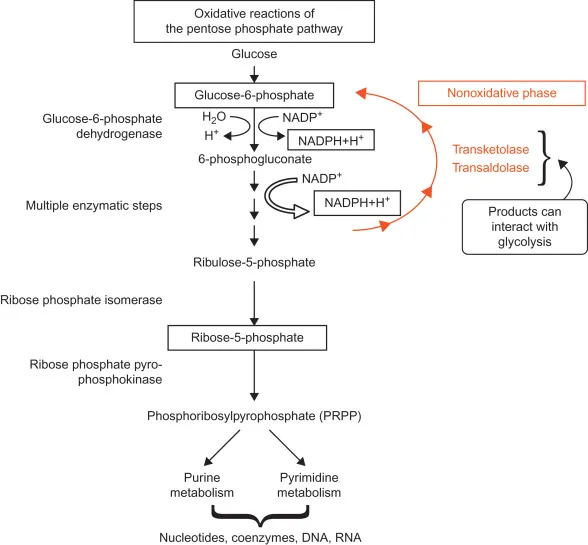
Glycolytic Pathway
Ten enzyme-catalysed steps
- Hexokinase: Glucose is phosphorylated to glucose-6-phosphate using ATP. Magnesium is a cofactor.
- Phosphoglucose isomerase: Glucose-6-phosphate is isomerized to fructose-6-phosphate.
- Phosphofructokinase: Fructose-6-phosphate is phosphorylated to fructose-1,6-bisphosphate using ATP. Magnesium is a cofactor.
- Aldolase: Fructose-1,6-bisphosphate is cleaved into two 3-carbon molecules: dihydroxyacetone phosphate (DHAP) and glyceraldehyde-3-phosphate (GAP).
- Triose phosphate isomerase: DHAP is converted to GAP.
- Glyceraldehyde-3-phosphate dehydrogenase: GAP is oxidized and phosphorylated to 1,3-bisphosphoglycerate. NAD+ is reduced to NADH.
- Phosphoglycerate kinase: 1,3-bisphosphoglycerate transfers a phosphate group to ADP, forming ATP and 3-phosphoglycerate.
- Phosphoglycerate mutase: 3-phosphoglycerate is converted to 2-phosphoglycerate.
- Enolase: 2-phosphoglycerate is converted to phosphoenolpyruvate.
- Pyruvate kinase: Phosphoenolpyruvate transfers a phosphate group to ADP, forming ATP and pyruvate.
Magnesium's Role:
Magnesium ions play a crucial role in several steps of glycolysis, acting as a cofactor for enzymes like hexokinase and phosphofructokinase. They help stabilize negatively charged phosphate groups during these reactions and are essential for enzyme activity.
Key points about the glycolytic pathway:
Two phases: The first five steps are considered the energy investment phase, consuming ATP, while the last five steps are the energy payoff phase, producing ATP.
Net yield: For each glucose molecule, glycolysis produces a net gain of two ATP and two NADH molecules.
Regulation: The enzyme phosphofructokinase is a key regulatory point in glycolysis.
Location: Glycolysis occurs in the cytoplasm of cells.
..
Glycolysis
Hexokinase (HK)
Phosphofructokinase (PFK)
Magnesium (Mg2+)
MgATP2
Phosphoglycerate Kinase
Pyruvate Kinase
Hexokinase
Function:
Hexokinase is the first enzyme in glycolysis that phosphorylates glucose, converting it into glucose-6-phosphate. This is an irreversible step, effectively trapping glucose within the cell and committing it to the glycolytic pathway.
Glucose-6-phosphatase dehydrogenase (G6PD) deficiency is the most common enzyme deficiency in humans
..
Potential Triggers:
Medications: Certain medications like antimalarials (primaquine), antibiotics (nitrofurantoin, dapsone, and sulfonamides), and aspirin can trigger G6PD deficiency symptoms.
Infections: Infections like hepatitis A, hepatitis B, typhoid fever, and pneumonia can also exacerbate G6PD deficiency symptoms.
Naphthalene: This chemical, found in mothballs, is also a known trigger.
Fenugreek seeds
Fava beans
Emotional Stress: Stress can also be a contributing factor.
..
https://en.m.wikipedia.org/wiki/Phosphofructokinase
https://en.m.wikipedia.org/wiki/Glucose_6-phosphate
https://microbiologyinfo.com/glycolysis-10-steps-explained-steps-by-steps-with-diagram/
..
Methylenetetrahydrofolate reductase and psychiatric diseases
https://www.nature.com/articles/s41398-018-0276-6
Vicine, Divicine and Isouramil have been implicated as the toxic components of fava beans.
https://en.m.wikipedia.org/wiki/Divicine
https://en.m.wikipedia.org/wiki/Vicine
https://en.m.wikipedia.org/wiki/Heinz_body
..
Behavioral and Neurological Changes: Neuroinflammation, changes in neurotransmitter levels (influenced by gut microbiota), and the impact of toxins and metabolites on brain function can lead to a range of behavioral and neurological changes. Conditions linked to gut dysbiosis and BBB dysfunction include:
Neurodevelopmental Disorders: Autism spectrum disorder (ASD)
Neurodegenerative Diseases: Alzheimer's disease (AD), Parkinson's disease (PD), multiple sclerosis (MS), and amyotrophic lateral sclerosis (ALS)
Psychiatric Disorders: Depression, anxiety, and schizophrenia
Other conditions: Sepsis-associated encephalopathy and "brain fog" associated with viral infections like COVID-19.
RE: Intercellular Homeostasis